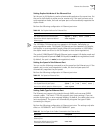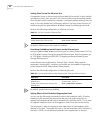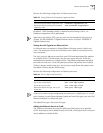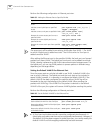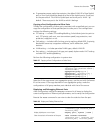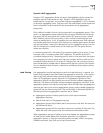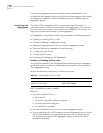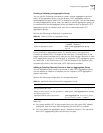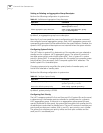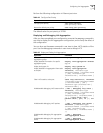
Configuring Link Aggregation 45
Dynamic LACP aggregation
Dynamic LACP aggregation allows automatic adding/deleting by the system but
prohibits manual configuration of users. Dynamic LACP aggregation can be
established for a single port; this is called single port aggregation. LACP is enabled
on dynamic aggregation ports. Only ports with the same speed, duplex mode and
basic configuration and connected to the same device can be aggregated
dynamically.
Only a defined number of ports can be supported in an aggregation group. If the
ports in an aggregation group exceed the port quantity threshold for that group,
the system will set some ports with smaller system IDs (system priority + system
MAC address) and port IDs (port priority + port number) as selected ports and
others as standby ports. If not, all member ports are selected ports. Both selected
and standby ports can transceive LACP protocol, but standby ports cannot forward
user service packets. Among the selected ports of an aggregation group, the one
with the lowest port number serves as the master port for that group and the
others are sub-ports.
In comparing system IDs, the system first compares system priority values; if they
are equal, then it compares system MAC addresses. The smaller system ID is
considered highest priority. Comparing port IDs works in the same way: the system
first compares port priority values and then port numbers and the small port ID is
considered highest priority. If the system ID changes from non-priority to priority,
then the selected or standby state is determined by the port priority of the system.
You can decide whether the port is selected or standby by setting system priority
and port priority.
Load Sharing Link aggregation may be load balancing and non-load balancing. In general, the
system only provides limited load balancing aggregation resources, so the system
need to rationally allocate these resources among manual aggregation groups,
static LACP aggregation groups, dynamic LACP aggregation groups and the
aggregation groups including special ports which require hardware aggregation
resources. The system will always allocate hardware aggregation resources to the
aggregation groups with higher priority levels. When the load sharing aggregation
resources are used up for existing aggregation groups, newly-created aggregation
groups will be non-load sharing ones. The priority levels (in descending order) for
allocating load sharing aggregation resources are as follows:
■ Aggregation groups including special ports which require hardware
aggregation resources
■ Manual and static LACP aggregation groups
■ Aggregation groups that probably reach the maximum rate after the resources
are allocated to them
■ Aggregation groups with the minimum master port numbers if they reach the
equal rate with other groups after the resources are allocated to them
When aggregation groups of higher priority levels appear, the aggregation groups
of lower priority levels release their hardware resources. For single-port
aggregation groups, if they can transceive packets normally without occupying
hardware resources, they shall not occupy the resources.



